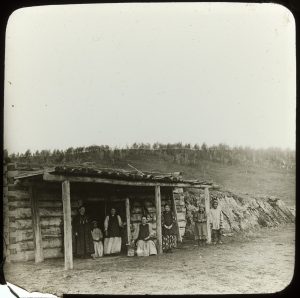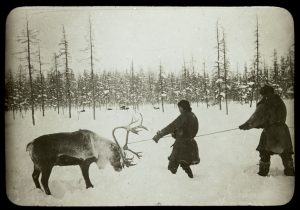In 1903 the Australian ornithologist Robert Hall (1867-1949) embarked on his major expedition to Siberia (via Japan and Korea), to collect specimens and eggs of Siberian birds known to migrate to Australia in summer.
He was accompanied by naturalist Richard Ernest Trebilcock (1880 -1976). The expedition lasted from February to December, and they travelled 3000 miles (4828 km) along the Lena River to its mouth, collecting 90 species totalling 401 specimens. Hall shot the birds and Trebilcock was taxidermist and photographer.
After reaching Vladivostok at the end of May, their first stop was Irkutsk on Lake Baikal. They travelled by horse and cart and boat to the Lena River, reaching the delta on 12 July 1903. They were on the Lena River for almost eight weeks.
Richard Ernest Trebilcock, Group on ship on the Lena River, Siberia, 1903, glass lantern slide, MS9247/68/4
Hall hoped that his expenses would be covered by Australian institutions, but when this did not eventuate, he sold the bird skins to the Rothschild Museum at Tring, Hertfordshire, England.
Upon their return to Australia, both Trebilcock and Hall gave many lectures about the expedition. Reports of the journey appeared in the daily papers of Melbourne and Geelong, and in ornithological publications.
Among other documents in the collection of the Royal Australasian Ornithologists’ Union, ( MS 9247), there are accounts by Trebilcok, as well as a set of 33 lantern slides that document the expedition and show the local people. Lantern slides are glass transparencies, created from photographs, which can be projected during lectures, similar to modern day slides. The glass lantern slides in our Collection are the few dozen that survive from Hall’s and Trebilcock’s lectures.


Images: Richard Ernest Trebilcock, Four people in fur coats, 1903, glass lantern slide, MS9247/68/19; Group of people in front of log dwelling, in the far north of Siberia, 1903, glass lantern slide, MS9247/68/32
Most of the images were taken by Trebilcock, but at least one lantern slide is from an original photograph by the Russian photographer Ivan Vasilievich Popov, who photographed the people of Siberia.
The images are fascinating, showing fields of snow, the local people, and most charming of all, reindeer. The whole set of lantern slides has been digitised and can be viewed online.
Richard Ernest Trebilcock, after Ivan Vasilievich Popov, Two people pulling reindeer, 1903, glass lantern slide, MS9247/68/8
References:
Information based on first-hand accounts by Treblicock. The history is discussed by Libby Robin in her book, The Flight of the Emu: a hundred years of Australian ornithology 1901-2001, 2001, Carlton, Vic. : Melbourne University Press, pp. 32-35.
The album by Popov, Peoples of Siberia: The Buryats and Yakuts, is held by the Irkutsk State University, Regional Research Library, Irkutsk, Russia and digitised by the Library of Congress on Global Gateway. Thank you to the researcher Melinda Caracella for this information.
Olga Tsara, Librarian, Heritage Collections




Another treasure rediscovered in our wonderful state collection. Thank you Olga.
Amazing piece.Thanks for sharing this
Wonderful approach and great initiation. Keep sharing.
good article, thanks! and pictures are good
Thank you. So glad you liked it. Olga
nice post
Siberia is no longer the same as the birds of that region. Unfortunately, a person destroys all life on his way.
Siberia is no longer the same as the birds of that region. Unfortunately, a person destroys all life on his way.
Great initiation and approach. Please share more.
the information you provide is very useful for others, thank you for making it.
Very nice post, Great blog, Thanks